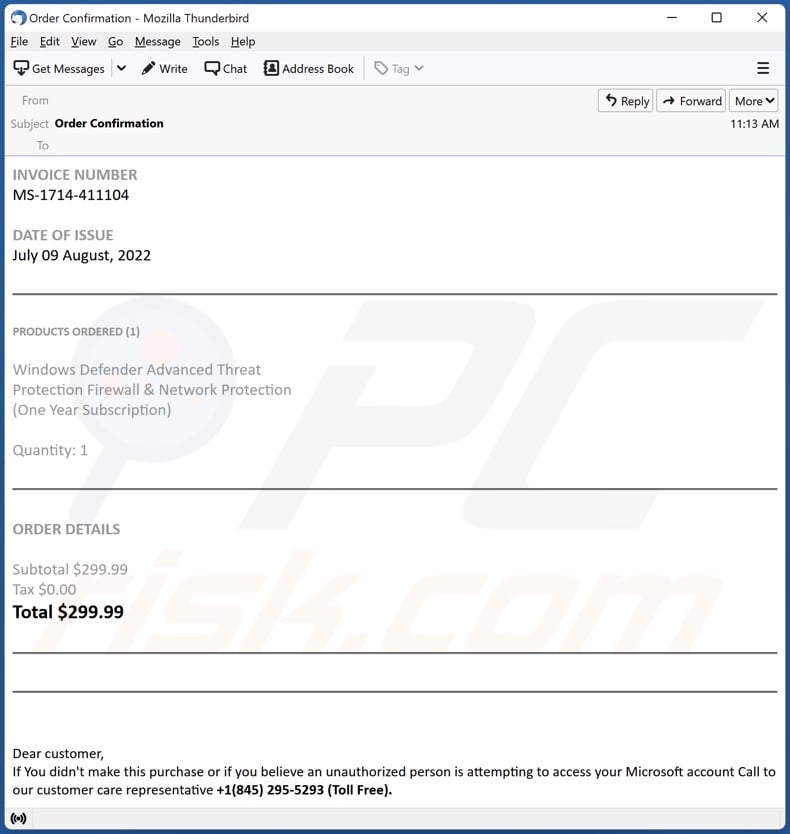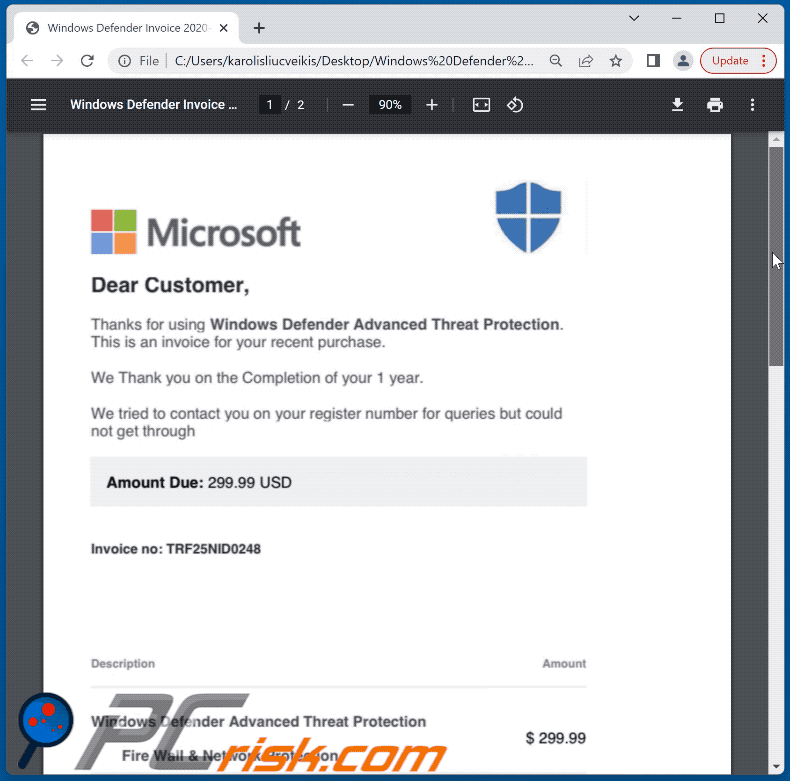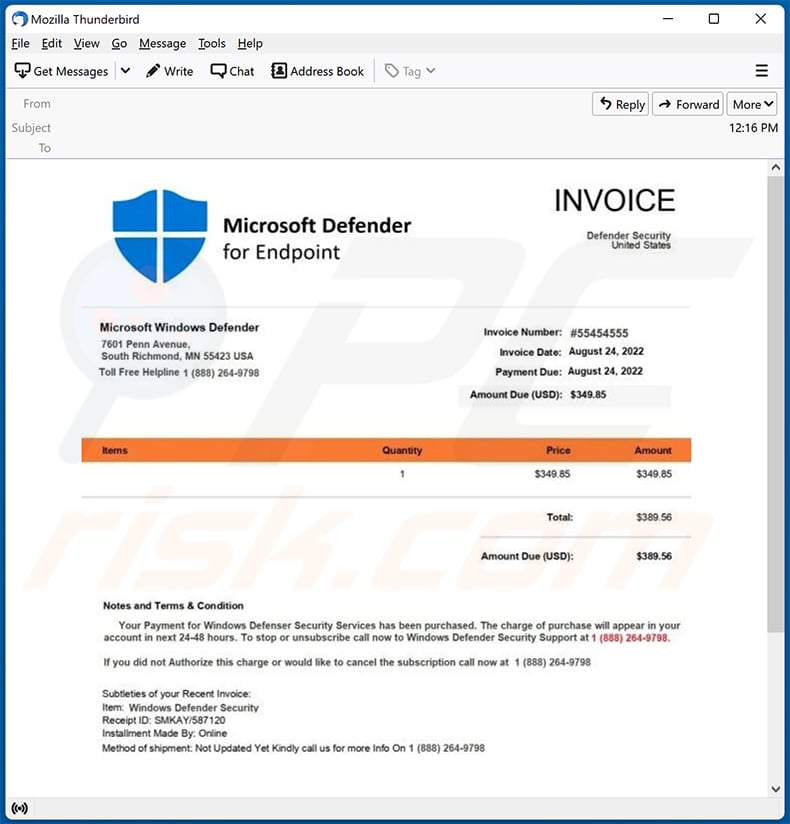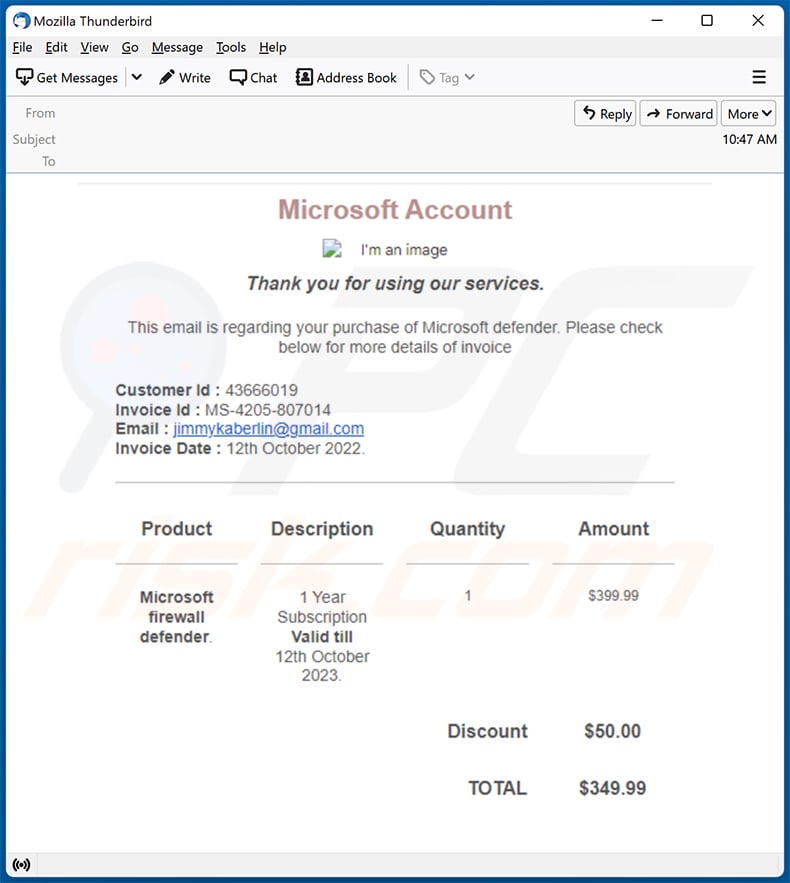Avoid getting scammed by fake "Windows Defender Subscription" emails
Phishing/ScamAlso Known As: Windows Defender Subscription spam email
Get free scan and check if your device is infected.
Remove it nowTo use full-featured product, you have to purchase a license for Combo Cleaner. Seven days free trial available. Combo Cleaner is owned and operated by RCS LT, the parent company of PCRisk.com.
What kind of email is "Windows Defender Subscription"?
Our analysis of the "Windows Defender Subscription" email revealed that it is spam. This fake letter is presented as a notification regarding the purchase of a one-year subscription for the Windows Defender security software.
It must be emphasized that this is a scam, and it is in no way associated with the Microsoft Defender Antivirus (formerly known as Windows Defender).

"Windows Defender Subscription" email scam overview
The scam email with the subject "Order Confirmation" (may vary) presents recipients with the product they ordered - a one-year subscription for "Windows Defender Advanced Threat/ Protection Firewall & Network Protection". The price is listed as 299.99 USD. The spam letter states that if the recipient has not made this purchase or suspects that an unauthorized party made it, they are to call the free helpline.
Evidently, this spam mail aims to trick recipients into calling the provided telephone number; however, how the scam progresses from that point on may vary.
It is likely that the scheme will follow a model similar to refund scams. In these, the victim is informed that the sum has already been subtracted, but the transaction can be reversed. The scammers request users to allow them remote access to their device - in order to aid with the refund process.
Victims are asked to sign into their bank account while the cyber criminals pretend not to see the screen and the entered log-in credentials. Alternatively, the scammers may redirect users to phishing sites that record the log-in credentials.
In the case of the first scenario, once the real bank account is accessed - the victim's screen is blackened while the scammers carry out nefarious actions. The user is usually asked to enter the refund amount themselves (and as they cannot see what they type) are deceived into thinking that they transferred too much money into their account.
The cyber criminals can create this impression by moving funds within the victim's account (e.g., from checking to savings) or by editing the webpage's HTML to appear as though a much larger sum was transferred. The scammers then ask the nonexistent excess to be returned (often accompanied by sob stories about potentially lost jobs).
Cyber criminals request the money to be transferred in difficult or impossible to trace methods, such as cryptocurrencies, gift cards, pre-paid vouchers, or even hidden in innocuous package contents and shipped.
Emails like these "Windows Defender Subscription" letters may also operate as more straightforward phishing scams - in which the victim is asked to provide personally identifiable or finance-related information over the phone or by entering it into a phishing webpage/file.
However, such emails may include more elements of technical support scams. These schemes likewise involve the scammers gaining remote access to the victim's device and then performing fake diagnostics that find imaginary issues. The cyber criminals can then remove genuine security tools, infect the system with malware (e.g., trojans, ransomware, etc.), deceive victims into purchasing fake anti-viruses or security subscriptions, and so on.
It is noteworthy that successfully scammed victims are commonly targeted repeatedly. In summary, by trusting scams like the "Windows Defender Subscription" emails - users can experience system infections, severe privacy issues, significant financial losses, and even identity theft.
| Name | Windows Defender Subscription spam email |
| Threat Type | Phishing, Scam, Social Engineering, Fraud |
| Fake Claim | Recipient has purchased a one-year subscription to Windows Defender Advanced Threat/ Protection Firewall & Network Protection. |
| Disguise | Purchase notification from Microsoft. |
| Scammer Phone Number | +1 888 671 5534, +1 (828) 316-6493, +1(845) 295-5293, +1(845) 666-0851, 1-877 392-0830 |
| Symptoms | Unauthorized online purchases, changed online account passwords, identity theft, illegal access of the computer. |
| Distribution methods | Deceptive emails, rogue online pop-up ads, search engine poisoning techniques, misspelled domains. |
| Damage | Loss of sensitive private information, monetary loss, identity theft. |
| Malware Removal (Windows) |
To eliminate possible malware infections, scan your computer with legitimate antivirus software. Our security researchers recommend using Combo Cleaner. Download Combo CleanerTo use full-featured product, you have to purchase a license for Combo Cleaner. 7 days free trial available. Combo Cleaner is owned and operated by RCS LT, the parent company of PCRisk.com. |
Spam campaign examples
We have analyzed thousands of spam emails; "Login Session Authentication", "Webmail Manager email scam", "FedEx Corporation email virus", "Summon To Court For Pedophilia", "I Regret To Inform You About Some Sad News For You" - are merely some examples of our latest finds.
These letters are used to carry out a wide variety of scams and also to proliferate malware. This mail can make various claims and wear different disguises. Due to how widespread spam mail is, we strongly advise exercising caution with incoming emails and messages.
How do spam campaigns infect computers?
Spam emails can distribute infectious files in the form of attachments or download links. These files can be PDF and Microsoft Office documents, archives, executables, JavaScript, and so forth.
When a virulent file is executed, run, or otherwise opened - the infection chain is jumpstarted. For example, Microsoft Office documents infect systems by executing malicious macro commands.
How to avoid installation of malware?
We highly recommend being vigilant with incoming mail. The attachments and links found in dubious/irrelevant emails and messages - must not be opened since that can result in a system infection. Additionally, it is important to use Microsoft Office versions released after 2010, as they have the "Protected View" mode that prevents macros from being executed automatically.
However, malware is not distributed exclusively via spam mail. Therefore, we advise downloading only from official/verified sources and activating/updating software with legitimate tools (as illegal activation tools - "cracks" and fake updates may contain malware).
We must stress that having a reputable anti-virus installed and kept updated is essential to device/user safety. Security programs must be used to run regular system scans and to remove threats and issues. If you believe that your computer is already infected, we recommend running a scan with Combo Cleaner Antivirus for Windows to automatically eliminate infiltrated malware.
Text presented in the "Windows Defender Subscription" scam email letter:
Subject: Order Confirmation
INVOICE NUMBER
MS-1714-411104
DATE OF ISSUE
July 09 August, 2022
PRODUCTS ORDERED (1)
Windows Defender Advanced Threat
Protection Firewall & Network Protection
(One Year Subscription)
Product Price
$299.99
Quantity: 1
ORDER DETAILS
Subtotal $299.99
Tax $0.00
Total $299.99
Dear customer,
If You didn't make this purchase or if you believe an unauthorized person is attempting to access your Microsoft account Call to our customer care representative +1(845) 295-5293 (Toll Free).
Appearance of a PDF document distributed using Windows Defender Subscription-themed spam emails:

Text presented within:
Microsoft
Dear Customer,
Thanks for using Windows Defender Advanced Threat Protection.
This is an invoice for your recent purchase.We Thank you on the Completion of your 1 year.
We tried to contact you on your register number for queries but could not get through
Amount Due: 299.99 USD
Invoice no: TRF25NID0248
Description Amount
Windows Defender Advanced Threat Protection
Fire Wall * Network Protection $ 299.99
Total $299.99If you have any questions about this invoice, simply reach out to our Support Team +1 619-377-0546 (Toll Free) for help.
You have 24 hours to refund this charge from the date of the transaction without being charges.
Our support team will gladly assist you with any questions or requests you may have - simply contact us through our dedicated channels:
If may take a few hours for this transaction to appear in your account.
Cheers,
The Billing Team
+1 619-377-0546 (Toll Free)Please don't reply to this email. To get in touch with us, +1 619-377-0546
Windows Defender Protection in USA are provided by Microsoft Payments Private Limited. Users are advised to read the terms and conditions carefully.
MVP Consumer Security 2014-2016
Windows Insider MVP 2016-2018NOTE: if email received in your spam box ask service desk to verify machine identity.
Please do not reply to this email. This mailbox is not monitored and you will not receive a response.© 2019 Windows Defender Protection All rights reserved.
Windows Defender Protection
Clearwater, FL 33756
Another example of "Windows Defender Subscription" scam email:

Text presented within:
Windows Defender for Endpoint
INVOICE
Defender Security United States
Microsoft Windows Defender
7601 Penn Avenue,
South Richmond, MN 55423 USA
Toll Free Helpline 1 (888) 264-9798Invoice Number: #55454555
Invoice Data: August 24, 2022
Payment Due: August 24, 2022
Amount Due (USD): $349.85
Items Quantity Price Amount
1 $349.85 $349.85
Total: $389.56
Amount Due (USD): $389.56Notes and Terms & Condition
Your Payment for Windows Defenser Security Services has been purchased. The charge of purchase will appear in your account in next 24-48 hours. To stop or unsubscribe call now to Windows Defender Security Support at 1 (888) 264-9798.If you did not Authorize this charge or would like to cancel the subscription call now at 1 (888) 264-9798
Subtleties of your Recent Invoice:
Item: Windows Defender Security
Receipt ID: SMKAY/587120
Installment Made By: Online
Method of shipment: Not Update Yet Kindly call us for more Info On 1 (888) 264-9798Your Request has been Processed Now And the Amount has been Charged.
Administrations has been Upgraded Now.
Any issues with the Order Please reach out to us Now On: 1 (888) 264-9798
Yet another example of Windows Defender subscription-themed spam email:

Text presented within:
Microsoft Account
Thank you for using our services.
This email regarding your purchase of Microsoft defender. Please check below for more details of invoiceCustomer Id : 43666019
Invoice Id : MS-4205-807014
Email : jimmykaberlin@gmail.com
Invoice Date : 12th October 2022.Product Microsoft firewall defender
Description 1 Year Subscription Valid till 12th October 2023
Quantity 1
Amount $399.99
Discount $50.00
TOTAL $349.99
Instant automatic malware removal:
Manual threat removal might be a lengthy and complicated process that requires advanced IT skills. Combo Cleaner is a professional automatic malware removal tool that is recommended to get rid of malware. Download it by clicking the button below:
DOWNLOAD Combo CleanerBy downloading any software listed on this website you agree to our Privacy Policy and Terms of Use. To use full-featured product, you have to purchase a license for Combo Cleaner. 7 days free trial available. Combo Cleaner is owned and operated by RCS LT, the parent company of PCRisk.com.
Quick menu:
- What is Windows Defender Subscription spam email?
- Types of malicious emails.
- How to spot a malicious email?
- What to do if you fell for an email scam?
Types of malicious emails:
![]() Phishing Emails
Phishing Emails
Most commonly, cybercriminals use deceptive emails to trick Internet users into giving away their sensitive private information, for example, login information for various online services, email accounts, or online banking information.
Such attacks are called phishing. In a phishing attack, cybercriminals usually send an email message with some popular service logo (for example, Microsoft, DHL, Amazon, Netflix), create urgency (wrong shipping address, expired password, etc.), and place a link which they hope their potential victims will click on.
After clicking the link presented in such email message, victims are redirected to a fake website that looks identical or extremely similar to the original one. Victims are then asked to enter their password, credit card details, or some other information that gets stolen by cybercriminals.
![]() Emails with Malicious Attachments
Emails with Malicious Attachments
Another popular attack vector is email spam with malicious attachments that infect users' computers with malware. Malicious attachments usually carry trojans that are capable of stealing passwords, banking information, and other sensitive information.
In such attacks, cybercriminals' main goal is to trick their potential victims into opening an infected email attachment. To achieve this goal, email messages usually talk about recently received invoices, faxes, or voice messages.
If a potential victim falls for the lure and opens the attachment, their computers get infected, and cybercriminals can collect a lot of sensitive information.
While it's a more complicated method to steal personal information (spam filters and antivirus programs usually detect such attempts), if successful, cybercriminals can get a much wider array of data and can collect information for a long period of time.
![]() Sextortion Emails
Sextortion Emails
This is a type of phishing. In this case, users receive an email claiming that a cybercriminal could access the webcam of the potential victim and has a video recording of one's masturbation.
To get rid of the video, victims are asked to pay a ransom (usually using Bitcoin or another cryptocurrency). Nevertheless, all of these claims are false - users who receive such emails should ignore and delete them.
How to spot a malicious email?
While cyber criminals try to make their lure emails look trustworthy, here are some things that you should look for when trying to spot a phishing email:
- Check the sender's ("from") email address: Hover your mouse over the "from" address and check if it's legitimate. For example, if you received an email from Microsoft, be sure to check if the email address is @microsoft.com and not something suspicious like @m1crosoft.com, @microsfot.com, @account-security-noreply.com, etc.
- Check for generic greetings: If the greeting in the email is "Dear user", "Dear @youremail.com", "Dear valued customer", this should raise suspiciousness. Most commonly, companies call you by your name. Lack of this information could signal a phishing attempt.
- Check the links in the email: Hover your mouse over the link presented in the email, if the link that appears seems suspicious, don't click it. For example, if you received an email from Microsoft and the link in the email shows that it will go to firebasestorage.googleapis.com/v0... you shouldn't trust it. It's best not to click any links in the emails but to visit the company website that sent you the email in the first place.
- Don't blindly trust email attachments: Most commonly, legitimate companies will ask you to log in to their website and to view any documents there; if you received an email with an attachment, it's a good idea to scan it with an antivirus application. Infected email attachments are a common attack vector used by cybercriminals.
To minimise the risk of opening phishing and malicious emails we recommend using Combo Cleaner Antivirus for Windows.
Example of a spam email:

What to do if you fell for an email scam?
- If you clicked on a link in a phishing email and entered your password - be sure to change your password as soon as possible. Usually, cybercriminals collect stolen credentials and then sell them to other groups that use them for malicious purposes. If you change your password in a timely manner, there's a chance that criminals won't have enough time to do any damage.
- If you entered your credit card information - contact your bank as soon as possible and explain the situation. There's a good chance that you will need to cancel your compromised credit card and get a new one.
- If you see any signs of identity theft - you should immediately contact the Federal Trade Commission. This institution will collect information about your situation and create a personal recovery plan.
- If you opened a malicious attachment - your computer is probably infected, you should scan it with a reputable antivirus application. For this purpose, we recommend using Combo Cleaner Antivirus for Windows.
- Help other Internet users - report phishing emails to Anti-Phishing Working Group, FBI’s Internet Crime Complaint Center, National Fraud Information Center and U.S. Department of Justice.
Frequently Asked Questions (FAQ)
Why did I receive this email?
Spam emails are not personal. Thousands of users receive identical letters.
I have provided my personal information when tricked by this spam email, what should I do?
If you have disclosed log-in credentials - change the passwords of all potentially compromised accounts and inform their official support. And if the exposed information is of a different personal nature (e.g., ID card details, credit card numbers, etc.) - contact the corresponding authorities without delay.
I have allowed cyber criminals to remotely access my computer, what should I do?
If you have permitted cyber criminals to remotely access your device, you must first disconnect it from the Internet. Afterward, remove the software the criminals used (e.g., TeamViewer, AnyDesk, etc.), as they may not need your consent to re-access your computer. Lastly, perform a full system scan. If any threats are detected - use an anti-virus to remove them without delay.
I have read a spam email but didn't open the attachment, is my computer infected?
No, merely reading a spam email will not result in a system infection. Malware download/installation processes are triggered when the files attached to or linked inside these letters are opened. However, the cyber criminals behind this mail can also infect victims' computers if they are allowed to access them remotely.
I have downloaded and opened a file attached to a spam email, is my computer infected?
If it was an executable (.exe, .run, etc.) - most likely, yes - your system was infected. However, document formats (.doc, .xls, .pdf, etc.) may require additional actions (e.g., enabling macro commands) to begin downloading/installing malware.
Will Combo Cleaner remove malware infections?
Yes, Combo Cleaner is designed to detect and remove threats. It is capable of eliminating most of the all known malware infections. However, it is essential to perform a complete system scan - since sophisticated malicious software tends to hide deep within systems.
Share:

Tomas Meskauskas
Expert security researcher, professional malware analyst
I am passionate about computer security and technology. I have an experience of over 10 years working in various companies related to computer technical issue solving and Internet security. I have been working as an author and editor for pcrisk.com since 2010. Follow me on Twitter and LinkedIn to stay informed about the latest online security threats.
PCrisk security portal is brought by a company RCS LT.
Joined forces of security researchers help educate computer users about the latest online security threats. More information about the company RCS LT.
Our malware removal guides are free. However, if you want to support us you can send us a donation.
DonatePCrisk security portal is brought by a company RCS LT.
Joined forces of security researchers help educate computer users about the latest online security threats. More information about the company RCS LT.
Our malware removal guides are free. However, if you want to support us you can send us a donation.
Donate
▼ Show Discussion